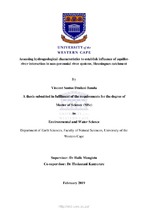| dc.description.abstract | Over half of total flows in the global river network are composed of non-perennial rivers. This indicates the importance of non-perennial river systems in supporting the biodiversity. It has been established that groundwater is one of the elements that control the flow regimes and classification (whether perennial or not) of a river system. However, the use of hydrogeological characteristics to establish the influence of groundwater on non-perennial river systems remain to be widely unpublished. This study, therefore, intends to conceptualize and explain the role of hydrogeological characteristics in non-perennial rivers, using the Heuningnes catchment in the Western Cape Province of South Africa as a case study. The study has argued that thorough characterization of aquifers is essential in order to adequately establish the extent of aquifer-river connectivity and how groundwater influences flows and chemical loading in non-perennial river systems. The study has three objectives namely: (i) to determine the aquifer characteristics (ii) to characterise the aquifer-river interaction and (iii) to conceptualize the groundwater flow system.
Records review, field, analytical and laboratory-based methods were used to collect and interpret geological, groundwater level, pumping test, hydro-chemical and environmental stable isotopic data in order to characterise groundwater occurrence, flow system and its interaction with the rivers of the study area. Water samples were taken from groundwater, surface water and rainfall during both dry and wet periods.
Results show that the study area has a topography-controlled water table with shallow depth to groundwater levels ranging on average from 3 - 10 m, which result into largely a local groundwater flow system. Transmissivity values determined from constant rate pumping test range between 0.17 and 1.74 m2/day. Results exhibit that the low transmissivity values are associated with the weathered nature of the Table Mountain sandstone and the unfractured Bokkeveld shale formations.
Hydrochemical data results indicate that both groundwater and river samples in the upstream part of the study area are characterised as fresh water with TDS values of less than 1000 mg/l while the downstream part has saline waters with TDS ranging from 2000 – 35000 mg/l. Results also show that Na-Cl is the dominant water composition for both groundwater and river water. The order of major ion dominance is similar for the two water sources, with concentration ranges from high to low in the order of Na+>Mg2+>Ca2+>K+ and Cl->SO42->HCO3- for cations and anions respectively. The similar patterns and trends in salinity and major ion data suggest the connectivity between the aquifer and the river. Environmental stable isotope data indicate river samples in upstream areas having depleted δ18O (-4.3 to -5.12‰) and δ2H (-22.9 to -19.3‰) signatures similar to groundwater indicating a stable and continuous groundwater contribution to the river flows. Meanwhile, high evaporative enrichment of δ18O (1.13 to 7.08‰) and δ2H (38.8 to 7.5‰) is conceived in river samples from downstream areas. Ionic ratios and isotope-salinity relationships suggest that groundwater chemistry is derived from sea sprays, evaporation and dissolution of Bokkeveld shale host rock.
Geological, hydrogeological, hydrochemical and environmental stable isotope data were used to develop a conceptual hydrogeological model which explains the role of groundwater in non-perennial river systems. Results indicate that the North East – South West fault on the north-eastern part of the study area seem to act as a conduit to groundwater flow thereby supplying water to the upstream rivers while the East -West fault in the northern part seem to act as a barrier to groundwater flow resulting into a hydraulic discontinuity between upstream and downstream areas. Meanwhile, the relatively low conductive formation in the downstream areas coupled with a relatively low hydraulic gradient (0.000843) suggests there is slow Darcian groundwater flows resulting in less flushing and high salinization of groundwater. Eventually, in the downstream part of the study area there is slow and minimal groundwater discharge to the rivers resulting into groundwater failing to maintain the river flows and pools. In general, rivers of the study area largely gain water from groundwater although the amount of groundwater discharge varies from one river segment to another in both upstream and downstream parts. The conceptual model has led to the development of a proposed optimum management of non-perennial rivers including the effects of groundwater abstraction on the river flows. | en_US |

